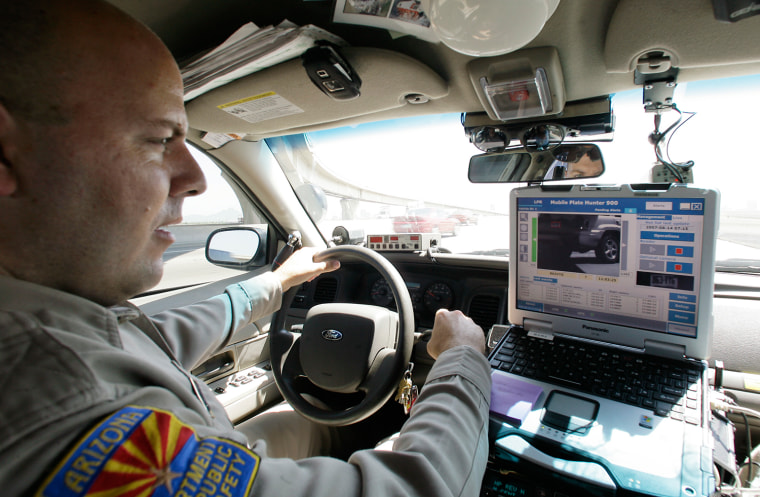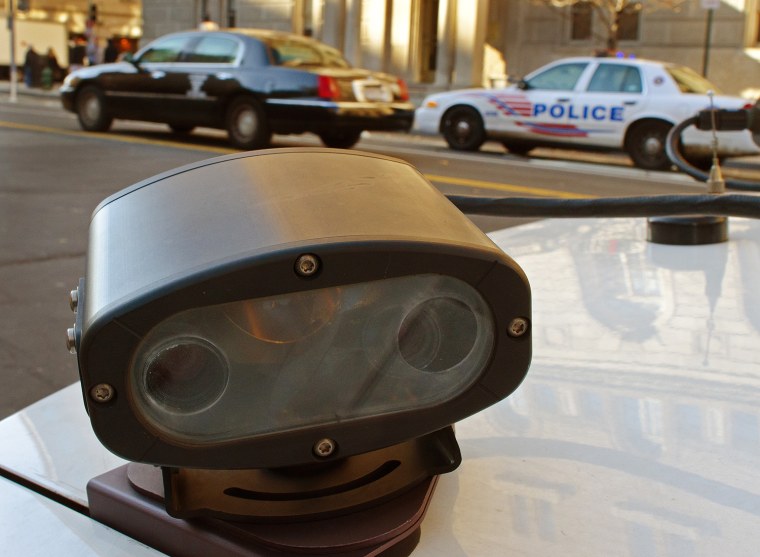
Drive down many highways, boulevards or small side streets in America, and your movements are being noted by electronic cameras. Eyes in the sky controlled by local police departments snap photos of every passing license plate and store the data, sometimes forever. Even the smallest of agencies now deploys these high-tech voyeuristic machines, creating massive databases where more than 99 percent of the entries represent innocent people.
All, warned the American Civil Liberties Union on Wednesday, for a one-in-a-million chance that the cameras might aid in the apprehension of a serious criminal.
"Plate readers are the most pervasive system of location tracking that people haven't heard of," said Catherine Crump, a privacy lawyer at the American Civil Liberties Union. She wrote the ACLU report released Wednesday questioning the way such cameras are being used. "Even though virtually all of us have had our cars logged into these databases, few know this technology exists."
Plate-reading cameras differ from speed cameras, red light cameras, or even parking enforcement cameras, which are designed to catch violators and criminals. Plate readers simply capture every car that goes by in a digital dragnet, then check the plate number against “hit lists” of cars associated with criminal activity.
The ACLU does not object to the use of so-called LPR (License Plate Reader) technologies, Crump said. Checking license plates can be an effective way to spot a stolen car or a fugitive. She objects to the long-term retention of that data, and what she argues is an out-of-whack balancing act between civil liberties and investigative tools.
"Law enforcement agencies should not be storing data about people who have done nothing wrong," she wrote in the report. "Ordinary people going about their daily lives have every right to expect that their movements will not be logged into massive government databases."
Data dilemma
The ACLU submitted Freedom of Information requests to 600 local and state police agencies seeking data on plate reader programs, and received 25,000 documents during the year-long project.

The plate readers are capable of spotting and storing massive amounts of data. Jersey City, N.J., for example told the ACLU it collected 2 million plate numbers during 2012. A statewide directive requires police agencies to preseve data collected for five years, leading the ACLU to conclude that the city has 10 million license plate records.
ACLU research suggests there is often little to show for all that data collection. For example, the state of Maryland told the ACLU it collected 85 million plates in 2012. Of those, only 1 in 500 resulted in a "hit," and 97 percent of those hits were minor violations such as failure to comply with emissions testing rules. Only 47 were associated with what the ACLU identified as potentially serious crimes.
"In short, Maryland’s license plate readers collect massive amounts of data, almost none of which are tied to any known or even suspected wrongdoing," the report said.
In Minnesota, the results were similar: 1.7 million plates scanned between 2009-2011, resulting in 852 citations, and 131 arrests.
David Roberts, senior program manager for the International Association of Chiefs of Police technology center, defended use of license plate readers, saying they provide real value by automating a task that patrol officers formerly did manually, an inefficient process that wasted resources. He said he’s not surprised the hit rates are low, but said it’s important to place those numbers in context.
“Those are 47 cases that may not otherwise have every been resolved,” he said, referring to Maryland’s data. “Even though the number is small, if you can make 47 apprehensions, keep those 47 dangerous people off the street, that has real value.”
The other 99.9 percent
Still, with well over 99 percent of citizens whose data ends up in these databases being innocent, Crump thinks plate reader programs should be reconsidered.
"With hit rates of 0.1 percent, we ought to spend some time thinking about the other 99.9 percent of people's data," she said.
Several agencies do. In Minnesota, for example, plate data that does not result in a hit must be deleted after 48 hours. In other spots around the country, it is never stored at all.
But that contrasts with Los Angeles County, which retains the data for two years; the Delaware Department of Homeland Security, which keeps it for five; and Yonkers, N.Y., which retains it indefinitely.
"We just think innocent people shouldn't end up in a database ... the fact that some agencies delete the data shows it can be done," Crump said.
Roberts said some communities place cameras at the main entrances and exits from their cities, logging each car that arrives and leaves. He said he knows some citizens might consider that tactic — sometimes called geofencing — disturbing.
“I understand people's concerns,” he said. “Part of this is how the agency is using the technology. In a fixed deployment like that, you want to be able to trigger an alert, say if you are looking for an abduction. This is a lot more efficient that having a person sit there monitoring a video screen."
Popularity grows as prices drop
The International Association of Chiefs of Police predicted problems with inconsistent plate reader policies back in 2009, when it published a report on the privacy impact of plate readers.
"This lack of regulation can cause the public to fear that the information collected by law enforcement agencies through their utilization of LPR systems might be mismanaged or misinterpreted with real-world consequences," it said at the time.
Roberts says the association makes no blanket recommendations on records retention, but simply says agencies should tie their policies “to their objectives.”
“If you are looking for parking violators, that’s obviously a different situation than if you are looking for dangerous criminals,” he said.
Plate readers have become more popular as their price goes down — simple stand-alone plate readers now cost as little as $15,000, and versions that mount on police cars are even cheaper. They are cheaper still when purchased with federal grant money, which continues to flow to municipalities for purchase of the gadgets. One advantage for the federal Department of Homeland Security — it often gains access to the information through data sharing arrangements.
While there is no hard data on how many communities deploy the camera, Roberts said a 2007 survey showed that more than half of large police departments used them then, and since that time deployment has been “growing very quickly.”
The ACLU report comes at a time of increased scrutiny for government surveillance programs, in light of the disclosures by former NSA employee Edward Snowden about controversial surveillance programs run by that agency. Crump says plate readers are another part of that tech-surveillance culture.
"In some ways, I think they are part of a broader trend that more and more emphasizes collecting absolutely everything everything (people) say or do," Crump said. "Even from people who are completely innocent of any crime."